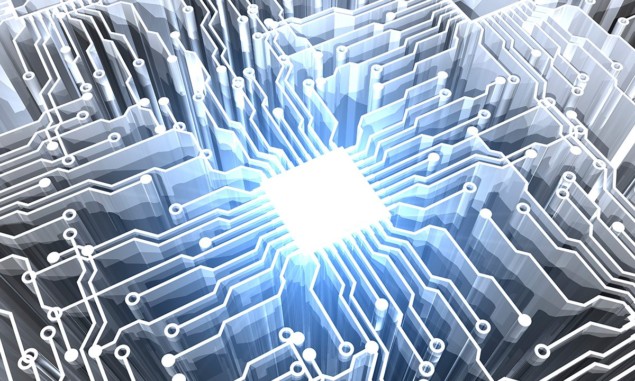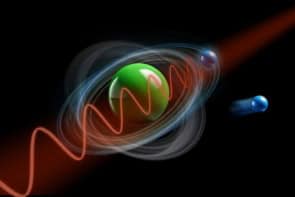
A quantum charged coupled device – a type of trapped-ion quantum computer first proposed 20 years ago – has finally been fully realized by researchers at Honeywell in the US. Other researchers in the field believe the design, which offers notable advantages over other quantum computing platforms, could potentially enable quantum computers to scale to huge numbers of quantum bits (qubits) and fully realize their potential.
Trapped-ion qubits were used to implement the first quantum logic gates in 1995, and the proposal for a quantum charged coupled device (QCCD) – a type of quantum computer with actions controlled by shuffling the ions around – was first made in 2002 by researchers led by David Wineland of the US National Institute of Standards and Technology, who went on to win the 2012 Nobel Prize for Physics for his work.
Quantum gates have subsequently been demonstrated in multiple platforms, from Rydberg atoms to defects in diamond. The quantum computing technology first used by IT giants, however, was solid state qubits. In these, the qubits are superconducting circuits, which can be mounted directly on to a chip. These rapidly surpassed the benchmarks set by trapped ions, and are used in record-breaking machines from IBM and Google: “Working with trapped ions, I would be asked by people, ‘Why aren’t you working with superconducting qubits? Isn’t that race pretty much already settled?’,” says Winfried Hensinger of the UK’s University of Sussex.
Progress is slowing
Recently, however, the progress made using superconducting circuits appears to be slowing as quantum computers integrate more and more qubits. To interact properly, the qubits must be identical and, whereas two copies of the same ion are guaranteed by quantum mechanics to be indistinguishable, fabricating identical circuits is near-impossible. Fabrication directly onto a chip also places superconducting circuits in thermal equilibrium with the chip: “If you build a superconducting qubit-based quantum computer, you have to cool that machine all the way to millikelvin temperatures,” says Hensinger. “That works fine if you have 10, 100…maybe 1000 qubits, but it’s going to be really challenging when you go to really large numbers.”
Some large companies have recently shown interest in the trapped ion platform, among them the multinational technology conglomerate Honeywell, which formed Honeywell Quantum Systems in 2020 to focus solely on the technology.
The firm’s latest result, unveiled in Nature, is the first demonstration of a fully functional QCCD. The device uses ytterbium-171 ions as qubits, which are chilled to their quantum ground states by barium-138 ions using a process called sympathetic cooling. The setup is contained in a linear trap above a chip cooled to around 10 K in a vacuum chamber. Ions held within the trap are shuffled between positions by dynamic electric fields, while quantum logical operations on the ions are performed by laser beams.
Teleported CNOT gate
The researchers demonstrate a sufficient set of gates to perform universal quantum logic. In addition, they created a teleported CNOT gate, which allows for non-destructive mid-circuit measurement – a crucial component for quantum error correction.
Their device has only six qubits, compared to 53 superconducting qubits in Google’s Sycamore – the machine with which Google claimed quantum advantage in 2019. However, Honeywell’s computer is arguably more powerful because of the flexibility of the QCCD architecture: “These ions are fully connected,” explains team member David Hayes; “With superconducting qubits or things like them, you can’t have a qubit over here talk to a qubit over there if there’s a whole bunch of qubits in the way – you have to move that information through there, and there’s a whole bunch of errors that will accumulate along the way.”

Honeywell says it will soon release ‘the most powerful quantum computer yet’
Hensinger is impressed with the Honeywell device: “This is really a phase change now we have a complete machine built on a shuttling-based approach,” he says; “It has been demonstrated with all the key ingredients. People often ask me when we can have a million-qubit machine: obviously there are still many, many challenges to be overcome, but I think this [research] demonstrates that it is a straight engineering path.”
Chris Monroe of University of Maryland, College Park, a co-author of Wineland’s on the original 2002 paper, who now runs the spin-off company IonQ, agrees: “In this field, every single little piece has been demonstrated separately. One of the important features of this work is that it integrated lots of them in one system. I love the QCCD idea: I actually coined that phrase myself.” He cautions, however, that, “the QCCD works great with six or eight ions, but when you get to 80, 200 or 300 ions, to enjoy that full connectivity you’re going to be spending a lot of time separating chains, moving ions around, getting them into position, doing the gate and then returning them to where they were.”



